May 03, 2017
Rural Health Literacy: Who's Delivering Health Information?
Related Articles
This is the second of the 2017 two-part series dedicated
to the rural aspects of health literacy. Read part one –
Rural
Health Literacy: Understanding Skills and Demands is Key
to Improvement.
In 2022, another two-part series addresses this topic:
A New
Era of Health Literacy? Expanded Definitions, Digital
Influences, and Rural Inequities and Educating
Future Healthcare Providers: Health Literacy
Opportunities for Webside Manners
Health literacy impacts the most everyday of health decisions. Over-the-counter medication use, health screening choices, medical insurance selection, and especially decisions about personal and family disease treatments are all influenced by the availability and clarity of heath information. Health literacy is a big concern since experts and researchers say that improving the nation's health is largely influenced by understanding health information.
Health literacy efforts in rural areas are unique. Distance and internet connectivity challenges make the struggle not just about processing and understanding basic health information, but about finding health information in the first place. To navigate these gaps, school nurses, newspapers, public libraries, churches, public health departments, and hub-and-spoke academic institutions are working in creative ways to deliver clear, understandable health information to the nation's rural residents.
On the Frontier: School Nurse Deb Pontius
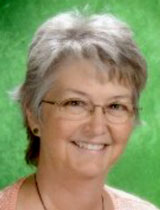
Two words frequently seen in the National Action Plan to Improve Health Literacy are “school” and “nurse.” Combine them and you get “school nurse,” the healthcare specialist who delivers health information to students, parents, school staff, and often to anyone in a community that needs information.
School nurse Deborah Pontius said health literacy is her lifelong passion, and health literacy principles are her everyday tools. Living in the frontier area of Lovelock, Nevada, Pontius knows that providing information that's clear and easy to understand is especially important for kids and parents in the rural and frontier areas of the country where long distances separate school children from healthcare resources.
Pontius teaches parents on a daily basis, covering topics like vomiting, lice management, and concussion treatment. For students, she teaches subjects like reproduction, hygiene, and CPR.
And, having served in multiple executive positions for the National Association of School Nurses, Pontius has written articles for her organization's peer-reviewed resource journal on verbal and written health literacy. One topic she frequently emphasizes is using plain language.
“My job is showing how everyday words actually maximize the professional look and sound of a medical message or form,” Pontius said. “And for school nurses, it helps get those school forms back to the nurse.”
In addition to school duties, Pontius also gives health literacy workshops and presentations to a wide range of groups that include lay audiences, professional nursing organizations, public health groups, and national rural organizations. She said though health literacy is seldom viewed as a hot topic for speakers, when she does present, the audience reaction is predictable. She believes this proves the importance of her information.
The audience always tells me that they didn't know what they didn't know, and that 'this information will change my practice.'
“I always hear the same thing,” Pontius said. “The audience always tells me that they didn't know what they didn't know, and that 'this information will change my practice.'”
Rural Newspapers: Hard Copy Health Information
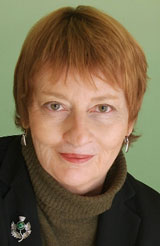
Former Nebraska state rural health director and previous newspaper publisher Dennis Berens recognized that rural residents needed more health information ahead of changes coming with the Affordable Care Act. So Berens collaborated with Allen Beermann, the executive director of the Nebraska Press Association, and healthcare journalist Trudy Lieberman, a past president of the Association of Healthcare Journalists. With support of The Commonwealth Fund, they created the Rural Health News Service (RHNS). Still the sole rural health newspaper service, RHNS is now distributed by 19 state press associations. Twice monthly RHNS offers Lieberman's “Thinking About Health” column through subscribing newspapers.
Armed with surveys that consistently show that over 85 percent of rural residents get a weekly newspaper, Beermann said a hard copy of health information can reach many readers, offering something different than TV and radio soundbites.
“Newspapers are read, re-read, clipped, and saved,” Beermann said. “That clipping is taken to clubs, card games, and shared in all kinds of settings. It's a natural medium for rural America.”
Lieberman said her column contains information for anyone, anywhere, but especially bridges a health information gap for rural Americans. Topics include information about Medicare and health insurance, hospital safety, and drug costs.
We always try to be factual and unbiased, with lots of explanatory information playing off current topics in the news to keep it current.
“We always try to be factual and unbiased, with lots of explanatory information playing off current topics in the news to keep it current,” Lieberman said.
Lieberman concludes her column asking readers to respond based on their own experiences. She shared several email responses with typical feedback: “Your article was very straightforward and easy to understand,” and “Keep writing.”
If You Need Health Information, “Next time you're in town, stop by the library”
According to Montanan Debbi Kramer, recently retired from a 20-year career as a rural librarian, 44 of her state's 82 public libraries are located in service areas of fewer than 5,000 people. Kramer, also executive director of the Montana Library Association, said small rural libraries can find any information their patrons need, especially when it comes to health information.
She explained that the organization's annual conference this past March actually had that latter goal in mind when it included presentations from the National Network of Libraries of Medicine on K-12 Science and Health Education Resources and Healthy Aging at Your Library: Connecting Older Adults to Health Information (no longer available online).
Kramer also said the Montana State Library provides assistance by making sure “we have the electronic links we need for up-to-date health information from reliable sources.”
For library patrons with less confidence with computers, Kramer would complete searches for them. Printing the information for a patron to take home wasn't a problem since she said good health literacy information is concise, typically only 10 pages or so. And, she'd tell people to make sure to let her know if the information wasn't helpful.
If it wasn't what they needed, I'd do another search for them, email them, or call them and tell them 'the next time you're in town, stop by the library.'
“If it wasn't what they needed, I'd do another search for them, email them, or call them and tell them 'the next time you're in town, stop by the library,'” Kramer said.
If the library information still wasn't enough, Kramer pointed out that rural Montana librarians have an additional resource.
“We have a lot of rural health clinics in Montana,” Kramer said. “If someone was still struggling with the available information, I'd tell them 'make an appointment at the clinic and one of the NPs [nurse practitioners] can talk to you.' We had a good relationship. A lot of rural libraries and clinics in Montana, we have to help each other.”
Alabama's Faith-Based Organization
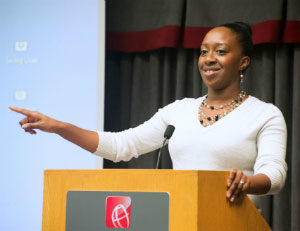
In time of need, rural citizens often turn to their schools, their healthcare facilities, and their faith-based organizations (FBOs). Carol Agomo, director of Community Affairs at The University of Alabama, said FBOs can be right there to meet health literacy needs.
“In rural communities with both schools and hospitals closing, and great distances between resources, we need to be able to lean on one another,” Agomo said. “Imagine how we can serve when we equip faith-based organizations to step in and fill health information gaps.”
Though specifically recognized as a partner in the 2010 National Action Plan to Improve Health Literacy, only a few FBOs are developing health literacy programs. Agomo is the director of her division's Saving Lives Initiative, a university community outreach effort combined with a health literacy research project. With a focus on diabetes, hypertension, and cholesterol, disparities that can be modified by behaviors, the program is based in a theological philosophy that links spiritual beliefs with faith and physical health. Another important feature of their program is sharing the information at pre-scheduled church meeting times, like bible study.
Agomo also said public health officials and military veterans' healthcare organizations have contacted her team to help provide health information to communities of faith.
When you are faith-based, you can speak to a patient's spiritual well-being and make that connection to their mental and physical health.
“Other health professionals are reaching out to us,” Agomo said. “When you are faith-based, you can speak to a patient's spiritual well-being and make that connection to their mental and physical health.”
She said clients report they are pleased with the health information they receive because it was easier to absorb when not intimidated by the environment and time limits of a medical appointment.
Oklahoma State Department of Health: Health Literacy Is Health Equity
The 2014 report, A Prescription Is Not Enough: Improving Public Health with Health Literacy, indicated that of 24 state public health departments responding to a survey, seven had personnel assigned to health literacy. One of those seven states was Oklahoma. When Tara Douglas started with the Oklahoma State Health Department five years ago, there was already a clear health literacy effort grounded in a philosophy of health equity.
“We embrace health literacy as 'health information used and understood by all Oklahomans,'” Douglas said.
Douglas, now a health education supervisor working in Purcell with three public health educators, said their team often directs their work to cover topics from the county needs assessment. For example, teaching patients how to talk to a provider. They also use evidence-based programs like CATCH, the Coordinated Approach to Child Health. For adult chronic disease management, an adult program, Living Longer Living Stronger is popular.

“We frequently learn from that program's post-test survey that attendees feel like they have more control over their health and body, and that symptom management techniques like meditation and positive imagery are really helpful,” Douglas said.
Douglas explained that for McClain County, health literacy efforts are a partnership that includes their local tribal partner, the Chickasaw Nation, and several health and human services programs in Purcell.
“In addition to our relationship with community partners, it's very convenient to have the school superintendent, the local health department, the Tobacco Settlement Endowment Trust, and the public library all in the same building with us,” Douglas said.
Arkansas: Academic Hub, With Clinic and Extension Agent Spokes
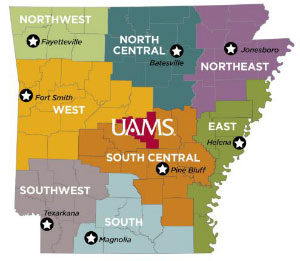
According to Dr. Kristie Hadden, executive director of the Center for Health Literacy (CHL) at the University of Arkansas for Medical Sciences (UAMS), over 35 percent of Arkansans have low health literacy, costing her state between $1.3 billion and $3 billion yearly. Hadden said her team's job is to make sure evidence-based methods are used to effect change in those numbers.
Starting in 2012 as a small rural health literacy program in the Center for Rural Health, Hadden first worked with the university's eight regional centers. She said that initial successes in those centers prompted an “organizational move to position the effort to include inter-professional faculty, serve all learners at UAMS, and partners across the state and country.” But, Hadden emphasizes that the original work in UAMS's eight spoke regional centers is still going strong.
At UAMS West in Fort Smith, center director Don Heard said he's been impressed by how much positive change can be driven by an answer to a simple, evidence-based question, “How confident are you in filling out medical forms yourself?”
Elizabeth Petray, UAMS West's behavioral health provider, said that question's answer becomes part of the electronic record and is clearly visible for each clinic visit.
“I can see it right along with name and age, and it's a good reminder for sharing verbal information, and deciding which handouts I send home with the patient,” Petray said.
A similar approach is used at UAMS South in Magnolia, where health educator Rebecka Wendling said thinking about health literacy guidelines about word choice and plain language are now second nature to patient care at their site.
Through the whole process, what we've learned is plain language benefits everybody, no matter what your education level. We all benefit from easy-to-read instructions and materials.
“Through the whole process, what we've learned is plain language benefits everybody, no matter what your education level,” Wendling said. “We all benefit from easy-to-read instructions and materials.”
According to Dr. Becky Hall, center director for UAMS East in Helena, their site is located in the heart of the Arkansas Delta country. Facing some of the worst health statistics in the nation due to extreme poverty and low literacy, Hall said health literacy has been integrated into Helena's daily patient care activities for some time. She's excited about the additional techniques that the CHL hub efforts have brought to their site, like the teach-back method.
“Teach-back is a tool allowing a provider to quickly assess a patient's knowledge,” Hall said. “If that assessment indicates a patient didn't understand the information, it can immediately be retaught.”
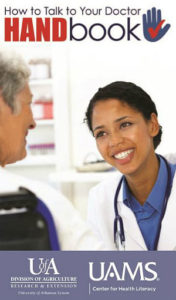
Lastly, to further unify the Arkansas health literacy effort, the CHL team moved its efforts outside of clinic and hospital walls by partnering with the state's Cooperative Extension Service county agents. Dr. Lisa Washburn, now a Cooperative Extension Service health specialist at the University of Arkansas System Division of Agriculture after a decade of previous Extension field work, explained that the new collaboration with UAMS connects Extension agents with patients identified by some of the regional clinics' literacy screening efforts. One educational tool created by the collaboration is the “HANDbook.” Extension agents build on the booklet's concept using the 5 fingers of a hand as reminders for things patients might want to discuss with their doctors.
Washburn said Arkansas Extension has also developed a new method of delivering health information, a method with recognizable roots.
“Arkansas is one of the few states to offer a Master Health Volunteer program, similar to other states' Master Gardener programs, but with expertise in health instead of horticulture,” Washburn said.
Washburn said the Extension Wellness Ambassador program uses the Extension education model with the volunteer not just teaching, but facilitating the learning process.
“And that's what the land grant system mission is all about,” Washburn said, “Taking research out to benefit real people.”
Health Literacy Tools
Agency for Healthcare Research and Quality
University of Arkansas for Medical Science's Center for Health Literacy
Centers for Disease Control and Prevention
National Institutes of Health
- Unique health information site created in, rather than translated to, Spanish: Portal de Información de Salud en Español de NIH
- Plain Language: Getting Started or Brushing Up

